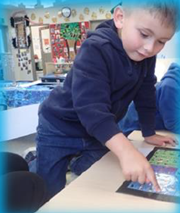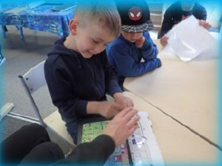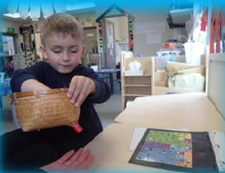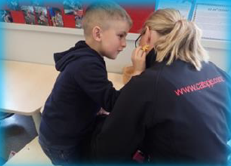Early Childhood AAC use - Communicating with George
We have three amazing learning stories to share with you from a young AAC user, George*, who was on our waitlist at the time they were written. George’s Ministry of Education Speech Language Therapist worked with his Early Childhood Education provider to implement a range of low & mid-tech AAC tools to help support his communication. They used a 77 location core vocabulary board, a Big Point, a Go Talk and eventually progressed to a more comprehensive communication book with a core vocab fold out. George is now undergoing a high-tech assessment and already has such fantastic AAC skills thanks to his dedicated team who supported his AAC journey from such a young age.
*name changed to maintain confidentiality. Stories and photos shared with permission from the whānau and kaiako.
I am developing my verbal communication skills to be an effective communicator (kōrerorero), to express my feelings, to negotiate, create and retell stories, to communicate information and solve problems when playing alongside my friends (ngā hoa) and teachers (kaiako).

George, today I introduced some new jolly phonic images into our group times. Before we started on your core board on a 1:1 situation, we revisited “p” again. Together we discussed the how you can feel the air brushing past your finger. You thought this was hilarious and kept giggling.
George we have spend time adding extra fringes onto your core board together. The fingers consisted of super hero images. George I felt it was important for you to do this with me and alongside me, as it gives you a sense of ownership for your core board.

As we put in the sheets, we discussed the images on them. What was really exciting is that you were able to start making three word sentences by pointing to the pictures. For example you were telling me that Gekko, Catboy and Owlette could move either fast or slow, and what their super powers were. You also started comparing them to other super heroes.
George, I have been away for two weeks and you have also had time off as well. So today when we sat down with the core board it was wonderful to see how many images you are retaining, and how you are very aware of how you can use them to express your ideas.
George you could point to the following:
Listen, put in.
Listen, take out.
Put on.
Put there.
Put here.
Listen stand George
Listen sit down.

Using the fringe you are able to point to an image and then point to images depicting different, fast, slow, cold, clean, dirty.
George, I have been hearing more sounds coming from you, especially when we are singing our centre song together. Today George, I was so proud of you as you were pointing to the images, you started echoing the words clearly as you were pointing! This shows me that you mohoi (know, understand) the concepts that as a kaiako team we have persevered with.
Your sense of humour is really starting to develop as your communication style becomes clearer to all. As we are working with your core board, placing objects in the basket and taking them out, you chose to post the items through the hole in the basket. Your facial expressions give you away, as they indicate that you are thinking and scheming, then the laughter starts rippling from you!

We then started working with the opposite concepts of: fast and slow, same and different, although we are familiarising ourselves where the images are by using toys to consolidate these learning concepts, we are also putting these concepts into mini stories! A great example of how you have taken ownership of your learning George, is when, after you had sorted the insects into the same and different piles using the core board, you then started pointing to the spider, then placed your fingers onto the different icons. You told me by pointing to the icons that the spider is there and is going on my arm. It is going up very slow. You then started laughing. I said “what are you doing? Can you tell me by pointing?” Spider going down, spider getting off.

George it is really exciting to see how you are able to use the core board to communicate not only with myself but how you are able to use it with and alongside your peers. Once we have worked a short time together, you have then been working with your core board either at the activity we have been working on, or moving to another area of play with your peers. George you are very aware that this communication device is able to support you in contributing to the play around you and it is also giving you a voice with the play.
We have three amazing learning stories to share with you from a young AAC user, George*, who was on our waitlist at the time they were written. George’s Ministry of Education Speech Language Therapist worked with his Early Childhood Education provider to implement a range of low & mid-tech AAC tools to help support his communication. They used a 77 location core vocabulary board, a Big Point, a Go Talk and eventually progressed to a more comprehensive communication book with a core vocab fold out. George is now undergoing a high-tech assessment and already has such fantastic AAC skills thanks to his dedicated team who supported his AAC journey from such a young age.
*name changed to maintain confidentiality. Stories and photos shared with permission from the whānau and kaiako.
I am developing my verbal communication skills to be an effective communicator (kōrerorero), to express my feelings, to negotiate, create and retell stories, to communicate information and solve problems when playing alongside my friends (ngā hoa) and teachers (kaiako).

George, today I introduced some new jolly phonic images into our group times. Before we started on your core board on a 1:1 situation, we revisited “p” again. Together we discussed the how you can feel the air brushing past your finger. You thought this was hilarious and kept giggling.
George we have spend time adding extra fringes onto your core board together. The fingers consisted of super hero images. George I felt it was important for you to do this with me and alongside me, as it gives you a sense of ownership for your core board.

As we put in the sheets, we discussed the images on them. What was really exciting is that you were able to start making three word sentences by pointing to the pictures. For example you were telling me that Gekko, Catboy and Owlette could move either fast or slow, and what their super powers were. You also started comparing them to other super heroes.
George, I have been away for two weeks and you have also had time off as well. So today when we sat down with the core board it was wonderful to see how many images you are retaining, and how you are very aware of how you can use them to express your ideas.
George you could point to the following:
Listen, put in.
Listen, take out.
Put on.
Put there.
Put here.
Listen stand George
Listen sit down.

Using the fringe you are able to point to an image and then point to images depicting different, fast, slow, cold, clean, dirty.
George, I have been hearing more sounds coming from you, especially when we are singing our centre song together. Today George, I was so proud of you as you were pointing to the images, you started echoing the words clearly as you were pointing! This shows me that you mohoi (know, understand) the concepts that as a kaiako team we have persevered with.
Your sense of humour is really starting to develop as your communication style becomes clearer to all. As we are working with your core board, placing objects in the basket and taking them out, you chose to post the items through the hole in the basket. Your facial expressions give you away, as they indicate that you are thinking and scheming, then the laughter starts rippling from you!

We then started working with the opposite concepts of: fast and slow, same and different, although we are familiarising ourselves where the images are by using toys to consolidate these learning concepts, we are also putting these concepts into mini stories! A great example of how you have taken ownership of your learning George, is when, after you had sorted the insects into the same and different piles using the core board, you then started pointing to the spider, then placed your fingers onto the different icons. You told me by pointing to the icons that the spider is there and is going on my arm. It is going up very slow. You then started laughing. I said “what are you doing? Can you tell me by pointing?” Spider going down, spider getting off.

George it is really exciting to see how you are able to use the core board to communicate not only with myself but how you are able to use it with and alongside your peers. Once we have worked a short time together, you have then been working with your core board either at the activity we have been working on, or moving to another area of play with your peers. George you are very aware that this communication device is able to support you in contributing to the play around you and it is also giving you a voice with the play.
